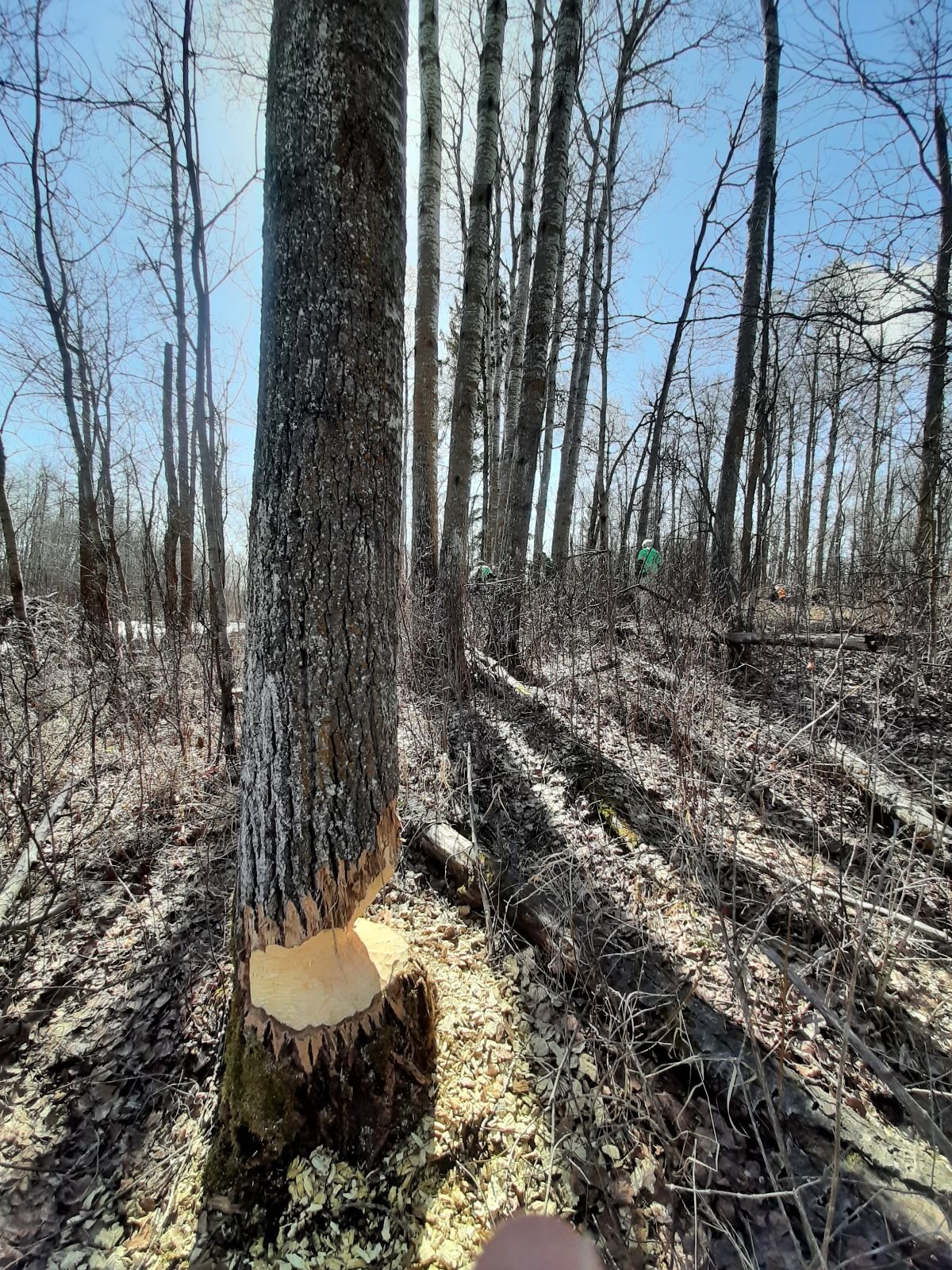When it comes to beavers, it’s common for landowners, municipalities, and even nature-lovers to have some conflict with these large and industrious rodents. However, they perform a crucial role in our ecosystems, and managing conflict between humans and beavers is an important consideration for successful land - and water - conservation. Read on to learn more about how EALT approaches beaver management!
Beavers grooming each other. Beavers are highly social animals who live in family groups. Image credit: Doris May.
Beavers and Land
Not only do beavers raise water levels on land and in waterways, but they also impact the deciduous trees and shrubs in their area by cutting down what they need for materials and food. Beavers use woody plants for three main purposes: building dams, building lodges, and food. They tend to stay away from coniferous trees, so it’s usually deciduous trees that are collected. As they clear out vegetation, they create areas where entirely new vegetation communities can arise. This can change forest dynamics by making the habitat less favourable for water-averse tree species, and more favourable for water-tolerant species, along with influencing succession by changing the light available as they remove larger trees.
Large tree felled by a beaver. Image Credit: Doris May
When it comes to which trees beavers select, aspen and poplar are definite favourites, and both are trees that our conservation lands have in abundance. Due to the relative lack of disturbance on our lands, sometimes the trees beavers choose to fell are quite large.
Occasionally, EALT gets messages from visitors about large trees being felled by beavers. This can pose a risk to human safety in the form of a fall risk. Beavers can choose to take down massive trees, and though it’s quite unlikely a person would happen to be walking under a tree at the precise moment it falls, we try to limit this risk by removing hazard trees poised to fall on trails.
Beaver Management and EALT
There are also situations where we get messages from neighbours or visitors who are concerned about beavers felling trees on roads or paths. In these cases, we step in to wrap wire around trees that may become a problem if they’re cut down. The wire serves as a barrier to beavers, and prevents them from cutting down the wire-wrapped tree. This is a low-impact, low-cost way to manage conflict between beavers and humans before it happens. Wire is relatively inexpensive, and with a group of volunteers, easy to install. This method can also be used to protect high-value trees, such as ornamental trees in city parks, and is quite effective. We would like to thank One Tree Planted for helping us with this activity!
Gallery: Installing wire around trees at Smith Blackburn Homestead.
Beavers and Water
A beaver dam at Larch Sanctuary.
Beavers are crucially important to the maintenance and stewardship of Alberta’s fresh water. Water levels in lakes, rivers, and wetlands have been steadily receding in central Alberta for the past 100 years, due to a multitude of factors, many of which are poorly understood. We’ve outlined the colonial history of beaver trapping in a previous blog, and this drastic reduction in the beaver population had consequences for the waterways in the region.
Beaver complexes (a network of streams, ponds, and wetlands created by beaver activity) have also been observed to be a great benefit when it comes to mitigating the impacts of fire, a natural force that has become increasingly troublesome in the past decade. With the help of tools such as drone footage, it has been observed that beaver-dammed rivers remain green throughout the course of wildfires, and wildlife actually take refuge in beaver ponds - and often survive because of it.
Carbyn Creek Wildlands supports a healthy population of beavers. This aerial photo shows how beavers expand waterways by damming creeks.
Beaver dams also assist in maintaining water quality, for fish and all life that relies on fresh water, including us. Wetlands act as water filtration systems, and water downstream from beaver dams is cooler, clearer, and more habitable for native fish species. Dams also slow the water that passes through them, allowing them to accumulate as groundwater. They also allow water to pass through them continuously throughout the year.
However, busy beavers pay little heed to human infrastructure, often causing conflict with humans. Fortunately, EALT doesn’t often encounter conflicts with raised water levels in natural areas, as our lands provide ample space for spontaneously created wetlands and beaver ponds. Some of our lands have seen receding water levels in their water body volumes, and it’s often encouraging to see signs of beavers on our conservation lands.
Human Conflict with Beavers
A beaver-created wetland at Smith Blackburn Homestead. When EALT secured this land in 2018, this area was a dry field.
Between flood risks, access concerns, and the loss of large trees, it’s easy to understand why people may be less than thrilled to see a beaver make themselves at home in their region.
On EALT’s conservation lands, we do our best to manage the needs of both wildlife and human visitors. Beavers are a crucial part of the landscape in the region and have been for hundreds of thousands of years. Even the name for the area, amiskwacîwâskahikan, means “beaver hills” in nēhiyawēwin (Cree), a name still used commonly throughout the region.
Though it’s hard to see large trees fall in a time when nature is more precious than ever, it’s important to remember that beavers are critical to maintaining surface water levels and wetlands. Beavers are natural experts at retaining water, so their presence here is also more important now than ever.
By supporting EALT with donations, volunteer work, or even spreading the word about us, you directly help give beavers the space they need to successfully steward our water, in areas with abundant trees and shrubs for them to eat and use. If you’d like to learn more about how we can share humanized landscapes with beavers, Working With Beavers has a lot of resources to browse.
Thank you for reading, and for supporting local nature conservation!










